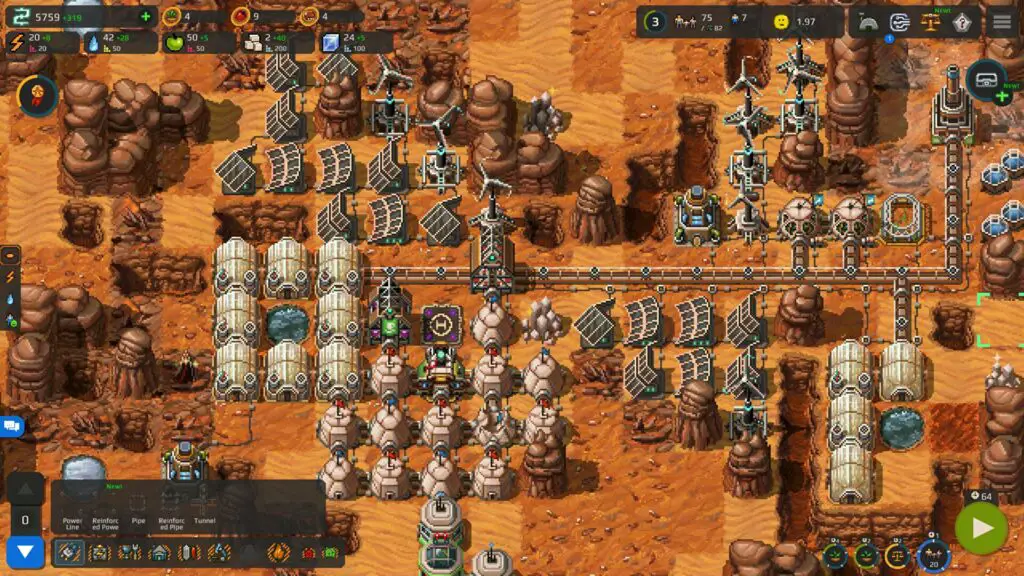If you’ve played a good chunk of the game so far, you may have found it more difficult than some other, similar titles out there. Anecdotally I’d agree- each campaign mission I’ve played so far has been tightly tuned, and while I’ve won each attempt (and only missed one optional objective so far), there were plenty of turns that came real close to serious problems. So beware! And hopefully this Farlanders guide will help you.
Sidenote: This farlanders guide is currently a work in progress. Accordingly, while I’ll update it when I can, please be patient. Thanks! The layout and scope of this guide may change over time, so if something seems missing, it may have been moved. If you still don’t find it (or just have a tip not yet in the guide), feel free to leave a comment!
Your Start Position
Starting off this farlanders guide – First and foremost, if a given map doesn’t seem to have a good start position, “restart” the mission to get a new map! There’s no use crippling your run right out of the gate. What makes a good start?
- #1: Access to one mineral site. Without this you go nowhere.
- #2: Good access to food, ideally 1-2 nearby pools of water that can form complete adjacent rings of greenhouses.
- #3: Map access. Ideally you’ll only be blocked from extending tunnels to other resources, underground entrances, etc. by 0-1 wasteland tiles. If 2-4 are in the way, or big mountains and canyons divide the map from your start point, terraform RNG could leave you trapped long enough to cripple you.
- #4: Another 1-2 mineral sites. Around turn 10 of any run you’ll find that 40 minerals from your base and one factory simply won’t cut it; it’s easily possible to burn upwards of 100 minerals a turn while expanding aggressively.
- #5: At least one nearby non-agricultural water site. Your colonists need to drink, after all, and condensers are too inefficient to cover all your supply. Ideally look for water next to other canyons- if you can form a 2×2 square of water pumps, they’ll all upgrade to max level for great output!
- #6: At least one silicon site reachable by midgame. While you technically can make your own silicon site with a mineral terraform tile, they’re rare enough that you’ll stumble hard if you rely on terraform RNG.
If you’ve got most of these, you’re off to a solid start.
Food, food, and more food
A basic guide for farlanders is food – While it is possible to deprioritize food in favor of, say, yet more minerals, this is most often a mistake. Food is among the pricier resources in the game, so you’re unlikely to afford to feed your people off of imports until late-game (and reaching late-game is difficult with this approach). Always do your best to form connected “Agricultural Rings” of 8 greenhouses surrounding water. Food production is likely to be your top use of workers, and properly setup agri-rings can increase output by up to 40%! In addition this sets you up for Spice production, which is a fantastic moneymaker (via moss/grass or export) and an utter necessity in larger cities (no one will move to your city if morale is below 0).
What happens if you suffer a food shortage? Real bad times. A number of your citizens leave (just enough to take you to zero, rather than negative food). The Martian Government fines you somewhere around 100 credits per evacuee. And worst of all? Any delicate resource or labor balances you’ve struck will be thrown into chaos as workplaces almost certainly wind up understaffed.
Farlanders 101 – Guide & Walkthrough
As if that wasn’t enough, there’s a knock-on effect: Since you’ll usually lose fewer folks than a full migration wave, city population milestones will need an additional wave to cover the difference. This can be the difference between victory and defeat in a tight game, or at minimum risks failing a bonus objective. Rather than risk a food shortage, it’s better to…
Turn down early migrants if need be
Early on, and often throughout the game, you’ll find yourself with most resource balances barely positive, including free workers. Accordingly it can be tempting to always get the largest migrant wave as early as possible… But that can easily eat massive holes in your food, water, and energy budgets, plus knock-on opportunity costs from building early housing for them.
More people are almost always a net plus, but not if they’ll just wind up starving later, screwing things up. Do what you can to expand in a somewhat-balanced, measured pace. Expanding too fast can lead to a death spiral.
Don’t forget morale!
Around 100-150 population, you’ll see your morale start to dip into the 0-1.5 range. Don’t let morale stay below 1 or 0 for too long! I nearly lost a game because I ignored morale-boosting technologies in favor of resources and pure money income, and got stuck below zero just short of my population goal.
… Which meant no one else would move in. Which meant I couldn’t get morale tech to get people to want to move in again. A death spiral. I only pulled out of it because I had over $6,000 income per turn, and was eventually able to terraform my city into a more efficient layout, which just got me to the point where parties would push me over the line and out of the spiral.
Science points are always tight so this means you might have to skip a tech you really wanted, but happier citizens earn a larger subsidy from the Martian Government, lessening the bite. Plus, y’know, you’ll retain the ability to actually keep growing.
Generally speaking, you’ll want to get Restaurants and/or Parks up and running before you hit 200 population. Community centers are practically free, as long as you can spare the workers for them. But try not to rely on Swimming Pools and Statues: both require rare terraform tiles that can often be better used elsewhere, and statues in particular only boost morale in a 3×3 square rather than the usual 5×5 “circle”.
Also, once you have good morale coverage in an area, convert your Basic Houses to Houses ASAP! This will both save you energy and fit up to 40% more people in the same area, massively boosting morale while keeping the labor costs of morale-boosting low.
Party Responsibly
I mentioned this in the previous section, but once you unlock Parties, they’re a great way of bumping morale by 0.5 or more for a turn. This seems useless… Until you’re at -0.3 morale, and you need a little kick to get any new migrants. Or if you’re at 1.8, and you want to bump up above 2 morale to get a full migrant wave to stay.
This said: Always make sure you only party when one turn remains until a migrant wave! I’ve messed this up before, and had to eat the 20-turn cooldown before I could do any useful partying again.
Farlanders 101 – Guide & Walkthrough
Pick a moneymaker, and stick with it
Trading is a fantastic addition to the game since the demo. With enough credits, you can buy anything you could possibly need, terraform multiple times per turn, and throw the occasional party. In general, you can make money by:
#1: Making an expensive good and selling it. Food and glass are good early-game staples for this, if you can build your colony right and generate a solid surplus. If your map has Winter or Dust Storms, you can even cash in on premium prices sometimes. Spices and Electronics are even better exports if you produce enough of them.
#2: Terraforming Mars: Not to be confused with the acclaimed boardgame OR your terraform tiles, you can earn credits by planting Bacteria, Moss, Grass, and Fungi on solid Ground. While this can be tricky to set up the profits can be insane; I’ve made over $4000 a turn from plants alone before. Bactera tiles make $20 by default, Moss ~$35, and Grass? $150. Plan your planting carefully; if you can’t upgrade tiers, it may not be worth it.
Important: If you don’t get a Biologist in your Specialist picks, this will be significantly tougher. Having a Biologist will allow your Bacteria to upgrade relatively easily to start your engine. Without one, a Bacteria will need to be surrounded by four other Bacteria to start your engine (in most configurations).
#3: Happy Citizens: I list this almost as an afterthought because any successful colony will make its citizens happy as a result of other successes, rather than happy citizens funding your overall success. If someone has had success with a morale-first colony, please leave a comment! For now, though, I consider this theoretically possible, but not a likely winner.
Check the Trading Market regularly
With each new Market refresh, deals change, as do the available terraform tiles. Look closely at listed resource deals- a green dot next to the button indicates a price favorable to you (two green dots is even better), while red dots indicate the opposite. Additionally various market conditions can alter prices; sometimes a given good is oversupplied or undersupplied and the price changes accordingly. Look to the bottom of the Trading screen to see any such alerts.
Just make sure you’ve got enough Landing Pad and/or Trading Shuttle capacity to handle the amount of Trading you need! Additionaly, be sure that you always leave enough landing pads available to accept migrant waves that you want. 1-2 works early game, but later on you may need 4, or possibly more on hyper late-game turns.
Farlanders 101 – Guide & Walkthrough
Also note that the Market will react to your trades, pseudo-randomly following a primitive supply and demand. This effect isn’t always pronounced or guaranteed, but adds up over time. This usually isn’t make-or-break in a balanced game, but over-reliance on imports or exports can cripple you if you’re not careful.

Terraform Wisely
Terraform guide tiles basically define Farlanders. Their power can easily allow you to remake the entire map to your liking, given enough time and a stable economy. This said, their default scarcity is somewhat fine-tuned to keep you on the edge, always lacking something. But there are several ways you can dance on that edge and take control.
While it can be tempting to spend your terraform tiles immediately, stop and think: do you need the resources that terraform can get you right now? If so, go ahead. But wait if you can- sometimes another upcoming terraform will pair with it perfectly, allowing you to make better moves and more efficient use of your terraforms.
Also, always look through the terraform tile market to see if something suits your needs. It may not always be affordable (looking at you, mineral and water tiles. $4,000 to $11,000 per tile!), but it may be just what you need. Credits exist almost entirely to buy you more and more terraform tiles; with them you can make an efficient, highly-tuned city that can weather any disaster or shortfall.
This said, don’t buy tiles willy-nilly. Even basic ones are expensive, and unwise purchases can mean you miss out on another tile you needed even more later on. As you play you’ll get an idea for what prices are fair, but here are some guidelines:
- Dig, Raise, TNT, and Restriction tiles are your “basics”. Trash Dump, is “uncommon”. Water and Minerals are your “rares”.
- Single-tile basic terraforms often cost between $850 and $1500. They’re an easy way to patch a part of the map, but if you focus exclusively on these, you’ll waste a lot over time because…
- 2-3 tile basic terraforms can cost anywhere between $1000 and ~$2800. If you find these especially cheap, this means you can wind up terraforming for around half the cost per map tile of single-tile basic terraforms.
- Trash Dump terraforms are kind of an oddball, both in usage and pricing. They’ll typically cost somewhere between $2,000 and $5000.
- Rares often cost between $4000 and $11,000. These are almost always something you’ll have to save up for, but they can also single-handedly pull you out of various death spirals.
- Don’t forget the Trash Dump! It’s utterly essential for underground work. Apply it to a Solid Wall, and it turns into a normal, destructible wall. Use it on Bedrock? It becomes destructible too. And more importantly: Apply it to a Stalagmite? And you get Bedrock, which is necessary for most underground construction.
Mind the weather
Certain campaign missions and Free Mission difficulties can have added weather effects which can throw a curveball in your planning and development. Keep them in mind to avoid sudden shortages! You’ll typically have some warning of their presence in the mission well ahead of any weather changes, so pay attention to the turn clock in the bottom right.
Note: ALL underground structures are immune to both current forms of weather (Winter and Dust Storms). That might change if the devs add Marsquakes though!
Winter: In Winter, all unprotected surface deposits of water freeze. Obviously if this happens to your main agricultural rings, you’re screwed. Thankfully the Water Dome can be built over water to keep it from freezing at a moderate material cost and a whopping 12 energy per dome. Water Domes will also instantly unfreeze any water they’re put over even in the middle of winter, saving the need for a fire terraform! Unfortunately, though, that’s the only method to melt surface water in winter; any water you terraform into place will freeze and stay frozen until winter ends.
Fortunately, underground liquid water doesn’t freeze in winter, but the extra cost of subterranean development (so many electronics!) is rarely worth it in my opinion. It’s much easier to manage the surface carefully. Thankfully active water pumps also keep water from freezing too! So if you see winter coming on and have planned a water pump expansion, it’s best to complete it before it freezes over and costs you extra to fix.
Overall, Winter isn’t too bad. Just make sure to have enough Energy saved up to keep your water liquid. With careful management you can even stockpile food to sell when winter drives prices sky-high, making Winter a potential net benefit.
Winter always ends on a Market refresh, so if it has lasted awhile and a refresh is coming up, you may be able to plan around summer.
Farlanders 101 – Guide & Walkthrough
Dust Storms: These are unfortunately MUCH more disruptive. A large dust cloud will spawn at a random part of the map edge and instantly block all migrants, trade, AND block sunlight for structures under the cloud, disabling any solar panels, condensers, and plant growth underneath. Each turn it will move roughly most of a storm diameter along a predetermined line, unblocking and blocking new structures as it moves.
Accordingly, it is critical to maintain both sufficient Energy and food buffers, and additionally ensure that you don’t absolutely rely upon migrants that’ll be blocked by a storm.
Dust Storms also muck with Market prices, typically making Food, Water, and Electronics significantly more expensive, while driving down the prices of minerals and glass. But if you can’t trade, why does this matter?
Storms will end when they cross the map edge again, and in turn immediately allow trading and migration to resume! It’s typically a narrow window of opportunity, but it’s easily possible to fetch around 50% more for your trades than you’d get otherwise.
Overall Dust Storms are manageable, but only with proper resource buffering, pre-planning. and a heavier focus on food production than normal. Occasional windows of opportunity make these potentially even better for you than Winter if you play your cards right!
Upcoming Content
For now, this is mostly a list of potential additions.
- More precise terraform tile prices
- Essential layouts- water pump, factory, and storage squares, efficient plant growth layouts and timings, good housing design, agricultural rings, etc.
- Screenshot examples in general
- (unlikely / slow-to-develop) Full Campaign and Free Mission walkthroughs
- Example high-quality map seeds
- More precise trade prices
- Specialists, what they do, and picking strategies
- “Labor Tricks”: shuffling workers between industries with large storage capacities for higher-efficiency production, morale manipulation, etc.
Author: 2501
You can check out the original article here – Original Post
We hope you enjoyed this Farlanders Guide | Tips/Tricks/ Walkthrough. We Also encourage readers to explore the original post and leave it a thumbs up, comment and motivate the original author for this great farlanders guide
View More Gaming Content & Guides Here: www.hideouthq/gaming


































